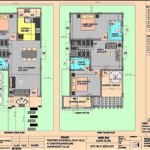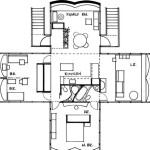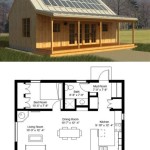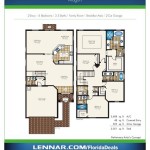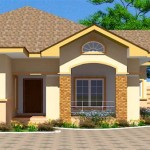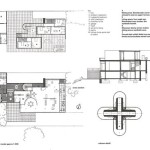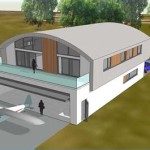40 Foot Wide Home Plans: Maximizing Space and Design
Home design is a multifaceted process involving numerous considerations, from budget and location to lifestyle and long-term needs. Among these considerations, the width of a property lot frequently dictates the overall architectural possibilities. For individuals or families seeking to construct a new home on a lot approximately 40 feet wide, specialized home plans become essential. These plans are specifically designed to optimize spatial utilization and create comfortable, functional living environments within the given dimensional constraints.
A 40-foot wide lot presents both challenges and opportunities. The primary challenge lies in balancing sufficient interior living space with necessary setbacks required by zoning regulations. Setbacks are minimum distances that buildings must be from property lines, roads, and other structures. Careful planning is crucial to ensure compliance with these regulations while maximizing the buildable area. The opportunity, however, lies in creative design solutions that exploit vertical space, incorporate open-concept layouts, and strategically utilize natural light to create a sense of expansiveness.
Selecting the right 40-foot wide home plan requires a thorough understanding of various design principles, common plan types, and crucial factors that influence the suitability of a particular plan for an individual's needs. This article explores the key aspects of 40-foot wide home plans, offering insights into design considerations, common styles, and essential planning elements.
Understanding Spatial Optimization in 40-Foot Wide Homes
The cornerstone of successful 40-foot wide home design is spatial optimization. Given the limited width, efficient use of every square foot is paramount. This necessitates a departure from traditional, compartmentalized layouts in favor of more open and interconnected spaces. Open-concept living areas, where the living room, dining area, and kitchen flow seamlessly into one another, are a common feature in these plans.
Vertical space plays a crucial role in maximizing usable area. Two-story designs, or even designs incorporating a finished basement or attic, can significantly increase the total living space without expanding the footprint of the home. Stairwells, however, must be carefully designed to minimize their impact on the floor plan. Spiral staircases or compact stair designs can be employed to save space without compromising functionality.
Storage is another critical consideration. Integrating built-in storage solutions, such as shelving units, cabinets, and closets, helps minimize clutter and maximize available floor space. Utilizing alcoves, under-stair space, and other often-overlooked areas for storage can contribute significantly to the overall efficiency of the design. Mudrooms, strategically located near entryways, can also serve as convenient storage areas for shoes, coats, and other outdoor gear.
Natural light is a crucial element in creating a sense of spaciousness. Large windows, skylights, and strategically placed glass doors can flood the interior with natural light, making the space feel brighter and more open. Window placement should be carefully considered to maximize sunlight exposure throughout the day while minimizing glare and heat gain. Light wells, which are vertical shafts that bring natural light into the center of the home, can also be incorporated, particularly in multi-story designs.
Common Design Styles for 40-Foot Wide Homes
While the width constraint imposes certain limitations, a wide range of architectural styles can still be adapted to 40-foot wide home plans. The choice of style depends on individual preferences, budget, and the overall aesthetic of the surrounding neighborhood.
Modern Farmhouse: This popular style combines the rustic charm of traditional farmhouses with modern amenities and clean lines. Key features include gabled roofs, board and batten siding, large porches, and open floor plans. The modern farmhouse style often incorporates natural materials, such as wood and stone, to create a warm and inviting atmosphere.
Contemporary: Contemporary home designs emphasize clean lines, geometric shapes, and minimalist aesthetics. Large windows, flat or low-pitched roofs, and open floor plans are characteristic features. Contemporary designs often incorporate sustainable building materials and energy-efficient technologies.
Craftsman: The Craftsman style, characterized by its handcrafted details and emphasis on quality materials, is another suitable option for 40-foot wide homes. Common features include low-pitched roofs with wide eaves, exposed rafters, and large front porches. Interior details often include built-in cabinetry, hardwood floors, and fireplaces with decorative surrounds.
Traditional: Traditional home styles, such as Colonial or Victorian, can also be adapted to 40-foot wide lots, although they may require more creative design solutions to accommodate their characteristic features. These styles often feature symmetrical facades, formal living spaces, and intricate detailing.
Townhouse Style: Townhouse designs maximize vertical space and create a narrow footprint. These plans are often multi-story and share at least one wall with a neighboring unit. This configuration is well-suited for maximizing density on smaller lots and can be adapted to various architectural styles.
Key Planning Elements for 40-Foot Wide Home Plans
Beyond the overall design style, several key planning elements are crucial for creating a functional and comfortable 40-foot wide home.
Driveway and Garage Placement: The placement of the driveway and garage is a significant consideration, particularly in narrow lots. Front-loading garages can dominate the facade and reduce curb appeal. Side-loading garages or rear-access garages, if permitted by zoning regulations, can provide a more aesthetically pleasing solution and free up space for landscaping.
Landscaping: Landscaping plays a vital role in enhancing the curb appeal and overall livability of a 40-foot wide home. Well-designed landscaping can create a sense of privacy, soften the architectural lines of the home, and provide a welcoming outdoor space. Vertical gardening solutions, such as trellises and climbing plants, can be used to maximize green space without encroaching on the limited yard area.
Interior Layout: The interior layout should be carefully planned to maximize functionality and flow. The placement of bedrooms, bathrooms, and other living spaces should be carefully considered to ensure privacy and convenience. Circulation patterns should be efficient and intuitive, minimizing wasted space and maximizing the usability of each room. The kitchen design is particularly important, as it often serves as the heart of the home. A well-designed kitchen should be both functional and aesthetically pleasing, with ample counter space, storage, and appliances.
Zoning and Building Codes: Understanding and complying with local zoning and building codes is essential. Zoning regulations dictate setbacks, height restrictions, and other limitations that can affect the design of the home. Building codes ensure that the home is safe and structurally sound. Working with an experienced architect or builder who is familiar with local regulations can help streamline the planning and construction process. They can help navigate the complexities of obtaining permits and ensure compliance with all applicable codes.
Future Needs: When selecting a 40-foot wide home plan, it is important to consider future needs. Will the family grow? Are there any accessibility requirements to consider? Choosing a plan that can be easily adapted to accommodate changing needs can save time and money in the long run. Flexible spaces, such as a bonus room or unfinished basement, can be converted into additional bedrooms, home offices, or recreational areas as needed. Designing for aging in place, with features such as wider doorways and grab bars in bathrooms, can also be beneficial.
In summary, 40-foot wide home plans demand careful planning and creative design solutions to maximize space and create functional, comfortable living environments. By understanding the principles of spatial optimization, exploring various design styles, and considering key planning elements, individuals can successfully navigate the challenges of building on a narrow lot and create a home that meets their specific needs and preferences. Consulting with experienced professionals, such as architects and builders, is highly recommended to ensure that the project is executed successfully and complies with all applicable regulations.

40 Wide New American House Plan With Home Office Potential 737026lvl Architectural Designs Plans

Home Plan Under 40 Feet Wide 84014jh Architectural Designs House Plans

40 Ft Wide Narrow Lot House Plan W Master On The Main Floor Plans Carriage Victorian

40 Foot Wide Modern Contemporary House Plan With 2 Story Living Room 95123rw Architectural Designs Plans

40 Foot Wide One Story Craftsman Bungalow Under 1800 Square Feet 28050j Architectural Designs House Plans

Main Floor Plan For 9950 Fb 4 Bedroom House Plans Craftsman 40 Ft Wide X P Two Story How To

Maximizing Slim Lots 4 New Layouts 40 Feet Wide Or Less Builder

Plan No 330033 House Plans By Westhomeplanners Com

9 Jaw Dropping 40x40 Barndominium Floor Plans Dream Awaits

19 45 Feet Wide House Plans Ideas How To Plan

